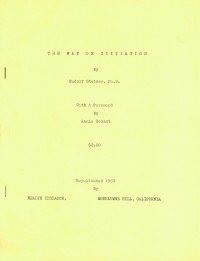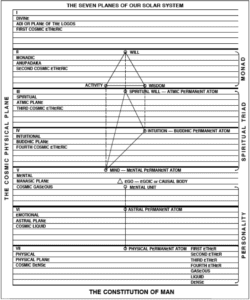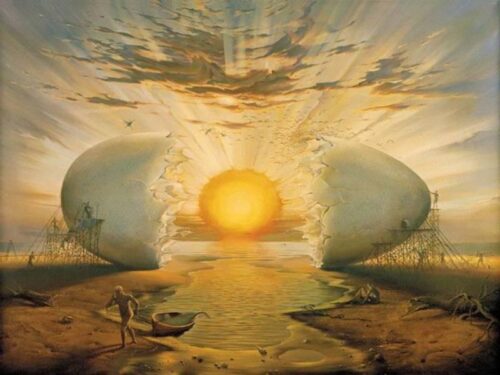Today we celebrate the conjunction, according to the heliocentric vision, of Mercury/Hermes, Lord of Harmony and Beauty, and Venus/Aphrodite, Lady of the Golden Proportion, by publishing this article on devic evolution: “… the two great evolutions (human and deva) find their group unity on the buddhic plane, and portions of both hierarchies blend and merge so as to form the body of the divine Hermaphrodite. Earlier, at certain fixed points, they may temporarily approximate each other. On the buddhic plane definite and permanent alliance may be seen.” (Alice A. Bailey – A Treatise on Cosmic Fire /328-29)
***
Devas…. [are] the sum total of the energy of substance and of substance itselfI. (Alice A. Bailey – A Treatise on Cosmic Fire /620)
The sumtotal of human and deva units upon a planet make the body vital of a planetary Logos, whilst the sumtotal of lesser lives upon a planet (from the material bodies of men or devas down to the other kingdoms of nature) form His body corporeal, and are divisible into two types of such lives:
a. Those on the evolutionary arc, such as in the animal kingdom.
b. Those on the involutionary arc, such as the totality of all elemental material forms within His sphere of influence. All the involutionary lives, as earlier pointed out, form the vehicles for the spirit of the planet, or the planetary entity, who is the sumtotal of the elemental essences in process of involution. He holds a position (in relation to a Heavenly Man) analogous to that held by the different elementals that go to the make-up of man’s three bodies, physical, astral and mental, and he is—like all manifesting beings—threefold in his nature, but involutionary. Therefore, man and devas (differentiating the devas from the lesser Builders) form the SOUL of a Heavenly Man. Other lives form his BODY. […] One group manifests the fire of matter, the other group the fire of mind, for the devas are the personification of the active universal mind, even though man is considered manasic in a different sense. Man bridges in essence; the devas bridge in matter. (Alice A. Bailey – A Treatise on Cosmic Fire /301-02)
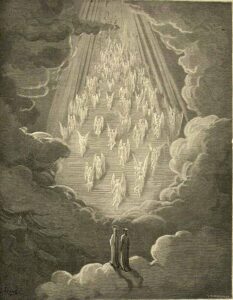
Working as members of that Hierarchy* are a great number of beings called angels by the Christian, and devas by the oriental. Many of them have passed through the human stage long ages ago, and work now in the ranks of the great evolution parallel to the human, and which is called the deva evolution. This evolution comprises among other factors, the builders of the objective planet and the forces which produce, through those builders, every form familiar and unfamiliar. The devas who co-operate with the Hierarchical effort, concern themselves, therefore, with the form aspect, whilst the other members of the Hierarchy are occupied with the development of consciousness within the form. (Alice A. Bailey – Initiation, Human and Solar /36)
[* The Hierarchy might be considered as the aggregate on our planet of the forces of the fifth kingdom in nature. This kingdom is entered through the full development and control of the fifth principle of mind, and its transmutation into wisdom, which is literally the intelligence applied to all states through the full conscious utilisation of the faculty of discriminative love. (Alice A. Bailey – Initiation, Human and Solar /21)]
The agents of the divine will
To understand more fully the function of the deva forces, a man must arrive at some understanding of the forces in his etheric body which, in their turn, are the consequence of his point of attainment—an attainment demonstrated by his astral (emotional) and mental natures and activities. These indicate his point of development.
The devas are the agents of the divine will because they are a consequence of the point of attainment of our planetary Logos as He exists outside the seven planes of our sphere of existence, the cosmic physical plane. They are conditioned by His cosmic astral and mental vehicles. In a definite sense, they are the agents of the Universal Mind, even though they are not mental as we understand that term.
They are sometimes regarded as blind forces, but that is only because they get their inspiration from levels of divine awareness outside the range of the human consciousness, no matter how high, or when used in its widest connotation.
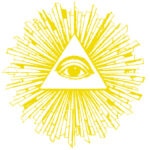 Their controlling Agent in manifestation is the Triangle of Energy to which we give the name the “Three Buddhas of Activity”. They are therefore closely connected with the third aspect of divinity. They are essentially the “eye within the Triangle”—a most familiar symbol to many today. They are the expression, in activity, of the “All-Seeing Eye”; through their agency God sees, and through them and the energy directed through them, He directs the creative process. They are under the complete control of the three Buddhas of Activity, Who are the cosmic Prototypes of the Lords of the three major rays, but not in the sense usually understood when the rays are considered in their relation to man. They are the correspondence of these three rays and are responsible for the entire manifested universe, but only within the orbit of the third aspect, the expression of the Universal Mind.
Their controlling Agent in manifestation is the Triangle of Energy to which we give the name the “Three Buddhas of Activity”. They are therefore closely connected with the third aspect of divinity. They are essentially the “eye within the Triangle”—a most familiar symbol to many today. They are the expression, in activity, of the “All-Seeing Eye”; through their agency God sees, and through them and the energy directed through them, He directs the creative process. They are under the complete control of the three Buddhas of Activity, Who are the cosmic Prototypes of the Lords of the three major rays, but not in the sense usually understood when the rays are considered in their relation to man. They are the correspondence of these three rays and are responsible for the entire manifested universe, but only within the orbit of the third aspect, the expression of the Universal Mind.
They come from the cosmic mental plane, just as the energy—distinctive of the second aspect—comes from the cosmic astral plane. God is mind. God is intelligent functioning. God is creative activity. These are the qualities of the deva evolution. God is love. God is relationship. God is consciousness. These are the three qualities of the Christ evolution. This latter evolution is carried on within the created sphere of influence of the third aspect. God is life. God is fire. God is pure being. These are the qualities of the spirit aspect, the omnipotent aspect of Deity. All these three aspects focus themselves and find an outlet for expression upon the levels of the cosmic etheric planes and upon the levels of the etheric planes known to humanity in the three worlds. The Law of Correspondences is infallible, if rightly approached and applied. (Alice A. Bailey – Rays and the Initiations /179-180)
The true builders
The building devas are the Ah-hi, or Universal Mind. They contain within their consciousness the plan logoic, and inherently possess the power to work it out in time and space, being the conscious forces of evolution.
They not only embody the Divine Thought but are that through which it manifests, and its actuating activity. They are essentially motion. The lesser builders are more particularly the material form which is actuated, and in their cohorts are the substance of matter (considering substance as that which lies back of matter).
They are that which produces concretion and which gives form to the abstract. The terms “rupa” and “arupa” devas are relative [Rupa, with form or body; Arupa, formless or bodiless. – Generally speaking, the term rupa is applied to all forms in the three worlds whilst the term arupa is applied to all forms through which existences manifest on the four higher levels of the solar system and the abstract levels of the mental plane], for the formless levels and the formless lives are only so from the standpoint of man in the three worlds; the formless lives are those which are functioning in and through the etheric body of the Logos, formed of the matter of the four higher planes of the system. From this point of view the mental plane provides an interesting consideration:—its three higher subplanes are positive, and centralise the positive force of the plane. This focussing of the positive affects the negative substance of the four lower planes and brings about likewise:
- The formation of force centres on the causal levels, those force centres being egoic groups in their various divisions.
- The concretion of substance, or the building of the dense physical body of the Logos.
On the physical plane of the solar system an analogous process can be seen taking place as regards the physical body of man, or his concrete manifestation. In his case, the fourth subplane is the focal point of positive force. On that plane are located the etheric centres of man, which have, in the evolutionary process and in the work of force direction, a relationship to his physical body similar to the relationship which groups of Egos on the mental plane have to the dense physical body of the Logos. This is a profound occult hint.
In the words “prana and the etheric body” (or life force and form) we have the key to the mystery of the solar and lunar pitris, and a hint as to the place of the physical body in the scheme of things. (Alice A. Bailey – A Treatise on Cosmic Fire /615-17)

The Devas of fire – the Greater Builders
I have divided the groups of devas and elementals into evolutionary and involutionary Builders—those who are in themselves positive force, and those which are negative force, the conscious and the blind workers.
[…] The greater Builders are the positive aspect of substance or of electrical phenomena whilst the lesser Builders are the negative aspect.
Two types of force are represented in the activities of these two groups and it is their interaction and interplay which produces Light, or the manifested solar system.
Their sumtotal is substance in its totality, the intelligent active form, built for the purpose of providing a habitation for a central subjective life.
They are also the sumtotal of the Pitris, or Fathers of mankind, viewing mankind as the race itself, the fourth kingdom in nature, the Heavenly Men in physical manifestation. This is a most important point to emphasise. These deva activities in relation to Self-Consciousness (which is the distinctive characteristic of humanity) can best be studied in the large, or through the consideration of groups, of races, and of the life of the scheme, the manifestation of one of the Heavenly Men.
When the student brings his study of deva work down to the terms of his own individual life he is apt to become confused through too close a juxtaposition.
The greater Builders are the solar Pitris, whilst the lesser Builders are the lunar ancestors. I would here explain the occult meaning of the word “ancestor”, as used in esotericism. It means literally initiatory life impulse. It is that subjective activity which produces objectivity, and concerns those emanatory impulses which come from any positive centre of force, and which sweep the negative aspect into the line of that force, and thus produce a form of some kind. The word “ancestor” is used in connection with both aspects.
The solar Logos is the initiatory impulse or Father of the Son in His physical incarnation, a solar system. He is the sumtotal of the Pitris, in the process of providing form. The union of Father (positive force) and Mother (negative force) produces that central blaze which we call the form, the body of manifestation of the Son. A Heavenly Man holds an analogous position in relation to a planetary scheme. He is the central germ of positive life or force, which, in due course of time, demonstrates as a planetary scheme, or an incarnation of the planetary Logos. A man similarly is the positive life or energy which, through action on negative force, creates bodies of manifestation through which he can shine or radiate.
[…] The lesser Builders are the negative aspect and are swept into action in group formation through the play of positive force upon them, or through the action of the conscious Minds of the system. I Costruttori minori sono l’aspetto negativo, e sono trascinati in azione in formazione di gruppo dall’influenza della forza positiva, o dall’azione delle Menti coscienti del sistema. (Alice A. Bailey – A Treatise on Cosmic Fire /612-14)
The Fire Elementals – the Lesser Builders
It will be apparent now that in our consideration of the deva Builders, great and small, of the solar system, we have hitherto practically confined ourselves to those who are the functioning agents in the three worlds of human endeavour. We have dealt briefly with the Builders on the evolutionary arc, the greater entities who either have passed through the human kingdom, and therefore have left that stage of evolution behind them in earlier cycles, or are at this time the “solar agents” of human manifestation. All these forms of divine existence represent—in their own place—aspects of positive force. We come now to the consideration of the lesser builders in the three worlds, those who represent the negative aspect of force, being on the involutionary arc, and who are, therefore, the recipients of energy and influences. They are worked upon by energy, and through the activity of the greater Builders are forced into different directions in space, being built into the differing forms. The energy that works upon them, as is well known, emanates from the second aspect, and in their totality they form the great Mother.
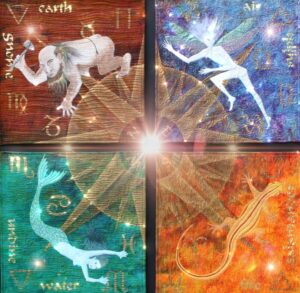
[…] Students should remember that we are dealing with involutionary substance, or atomic matter. This atomic matter is living substance, each atom being a tiny life palpitating with the vitality of the third Logos. These lives, being negative energy, are responsive to their polar opposite, and can (under the Law of Attraction and Repulsion) be built into forms which are the expression of the second aspect. Eventually the forms themselves become in their turn negative, and responsive to still another type of force, becoming recipients of the life of the first Logos when the fourth or human kingdom is reached.
This Treatise seeks to prove, that in the fourth kingdom the three fires meet:
- Fire by friction, or the negative Brahma Aspect, the third Aspect.
- Solar Fire, or the positive negative Vishnu Aspect, the second Aspect.
- Electric Fire, or the positive Shiva Aspect, the first Aspect.
Man in the three worlds, consciously or unconsciously, recapitulates the logoic process, and becomes a creator, working in substance through the factor of his positive energy. He wills, he thinks, he speaks, and thought-forms eventuate.
Atomic substance is attracted to the enunciator. The tiny lives which compose that substance are forced (through the energy of the thinker), into forms, which are themselves active, vitalised and powerful. What man builds is either a beneficent or a maleficent creation according to the underlying desire, motive, or purpose.
It is essential that we endeavour to make practical what is here to be imparted, as it is useless for man to study the groups of lesser builders, their functions and their names, unless he realises that with many of them he has an intimate connection, being himself one of the great builders, and a creator within the planetary scheme. Men should remember that through the power of their thoughts and their spoken words they definitely produce effects upon other human beings functioning on the three planes of human evolution and upon the entire animal kingdom. The separative and maleficent thoughts of man are largely responsible for the savage nature of wild beasts, and the destructive quality of some of nature’s processes, including certain phenomena, such as plague and famine.
It is of no value to man to know the names of some of the “army of the voice” unless he comprehends his relationship to that army, unless he apprehends the responsibility which is his to be a beneficent creator, working under the law of love, and not impelled to the creative act through selfish desire, or uncontrolled activity.
Physical Plane Elementals.
It should be remembered that the devas we have been considering are the originators of impulse, and the manipulators of energy in their own degree, and on their own plane. In connection with them are to be found, therefore, the recipients of force, or the multitude of lives of an elemental nature which form the sumtotal of the matter of a plane. These are swept on waves of energy, through the impulse of the Breath, and as the result of vibratory action, into all forms as we know them on the physical plane.
Therefore, in connection with manifestation on the physical plane the devas may be divided into three groups:
- The transmitters of the will of God, the originators of activity in deva substance. These are the greater builders in their various groups.
- The manipulators of the initiated energy. These are the myriads of workers with force who transmit the impulse in their turn to the elemental essence. They are the builders of lesser degree, but are on the evolutionary arc as are the first group.
- The recipients of force, the sumtotal of the living substance of a plane. These lives are passive in the hands of the builders of greater degree.
The three groups to be considered are:
- The elementals of densest matter.
- The elementals of liquid matter.
- The elementals of gaseous matter.
We must bear in mind as we study these three groups that we are not concerned with the transmitters, but with the manipulators and with the recipients of energy. (Alice A. Bailey – A Treatise on Cosmic Fire /887-90)
Life and evolution of devas
We will consider now the etheric levels of the physical plane or the four highest subplanes of the physical plane. These etheric levels are but gradations of physical plane matter of a rarer and more refined kind, but physical nevertheless. They are termed in most textbooks:
- The first ether, or atomic matter.
- The second ether, or sub-atomic matter.
- The third ether, or super-etheric matter.
- The fourth ether, or simply etheric matter.
The fourth ether is the only one as yet recognised by scientists, and is the subject of their present investigations, little though they may realise it.
On the atomic subplane are the permanent physical atoms of all humanity and the appropriated atoms of the deva kingdom. The devas do not develop as do the human race. They reincarnate in groups, and not as individuals, though each group is composed of units, and has nothing of the nature of the involutionary group soul. The group soul on the involutionary path and that upon the evolutionary are unlike; one is passing on to differentiation and is composed of entities animated by one general life; the other has differentiated, and each entity is a separate unit of the one life, complete in itself, yet one with the whole.
There are many types of life to be contacted on the four etheric levels, but we can only concern ourselves at present with the deva life, remembering that the deva evolution is of equal importance to that of the human. These devas are many in number, are of involutionary and evolutionary nature, and of all grades and types.
[…] Devas of all kinds and colours are found on the physical etheric levels, but the prevailing hue is violet, hence the term so often employed, the “devas of the shadows”. With the coming in of the ceremonial ray of violet, we have the amplification therefore of the violet vibration, always inherent on these levels, and the great opportunity therefore for contact between the two kingdoms. It is in the development of etheric vision (which is a capacity of the physical human eye) and not in clairvoyance that this mutual apprehension will become possible. With the coming in likewise of this ray will arrive those who belong thereon, with a natural gift of seeing etherically.
Children will frequently be born who will see etherically as easily as the average human being sees physically; as conditions of harmony gradually evolve out of the present world chaos, devas and human beings will meet as friends.
As the two planes, astral and physical, merge and blend, and continuity of consciousness is experienced upon the two, it will be difficult for human beings to differentiate at first between devas of the astral plane, and those of the physical. At the beginning of this period of recognition, men will principally contact the violet devas, for those of the higher ranks amongst them are definitely making the attempt to contact the human. These devas of the shadows are of a dark purple on the fourth etheric level, of a lighter purple, much the same colour as violet, on the third etheric level, a light violet on the second, whilst on the atomic subplane they are of a glorious translucent lavender.
[…] Thus in the service of humanity in some form or another lies attainment for these physical plane devas. They have much to give and do for humanity, and in time it will be apparent to the human unit what he has to give towards the perfecting of the deva kingdom. A great hastening of their evolution goes forward now coincident with that of the human family. (Alice A. Bailey – A Treatise on Cosmic Fire /910-14)
Angels will come closer to mankind
It might be of interest here to point out that when He comes Whom angels and men await, and Whose work it is to inaugurate the new age and so complete the work He began in Palestine two thousand years ago, He will bring with Him some of the great Angels, as well as certain of the Masters. The angels have ever been active in Biblical history, and will again enter into the lives of human beings with more power than has lately been the case. The call has gone out for them again to approach humanity, and with their heightened vibration and superior knowledge unite their forces with those of the Christ and His disciples for the helping of the race. They have, for instance, much to communicate anent colour and sound, and the effect of these two forces on the etheric bodies of men and animals and flowers. When what they have to impart is apprehended by the race, physical ills and sickness will be offset. The group of violet angels or devas who work on the four etheric levels will be especially active and they will work in the four main groups of men who are in incarnation at any given time. Four rays dominate at any period, with one of the four more potent than the other three. You have this idea symbolised in the four castes in India and you will find also that these four castes are found universally throughout the planet.
These four groups of angels are a band of servers, pledged to the service of the Christ, and their work is to contact men and to teach them along certain lines.
a. They will teach humanity to see etherically, and this they will do by heightening human vibration by interaction with their own.
b. They will give instruction in the effect of colour in the healing of disease, and particularly the efficiency of violet light in lessening human ills and in curing those physical plane sicknesses which originate in the etheric body.
c. They will also demonstrate to the materialistic thinkers of the world the fact that the superconscious world exists and that angels and men who are out of incarnation and possess no physical bodies can be contacted and known.
d. They will train human beings in the knowledge of superhuman physics so that weight shall be for them transmuted. Motion will become more rapid, speed will be accompanied by noiselessness and smoothness, and hence fatigue will be eliminated. In the human control of etheric levels lies the overcoming of fatigue and the power to transcend time. Until this prophecy is a fact and recognised as such, the meaning of the above words will remain obscure.
e. They will teach humanity how rightly to nourish the body and to draw from the surrounding ethers the requisite food. Man will concentrate his attention upon the etheric body and the work and health of the physical body will become increasingly automatic.
f. They will also teach human beings as individuals and as a race to expand their consciousness to include the superphysical. In the accomplishment of this, the separating web (the veil of the temple) which divides the physical plane from the unseen world will be recognised as a fact in nature by the scientist. Its purpose will be acknowledged. Eventually it will be destroyed, by man discovering how to penetrate it. The date is imminent. (Alice A. Bailey – The Externalisation of the Hierarchy /508-9)
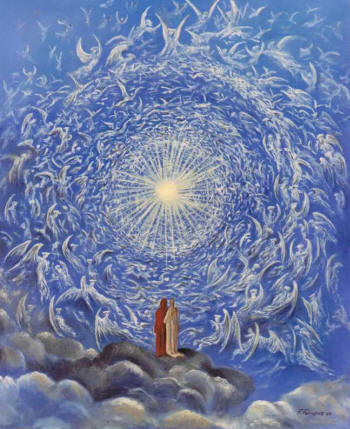
![[Info]](https://onlinebooks.library.upenn.edu/info.gif) Hartmann, Franz, 1838-1912: An Adventure Among the Rosicrucians (Boston: Occult Pub. Co., 1890) (page images at HathiTrust)
Hartmann, Franz, 1838-1912: An Adventure Among the Rosicrucians (Boston: Occult Pub. Co., 1890) (page images at HathiTrust)![[Info]](https://onlinebooks.library.upenn.edu/info.gif) Hartmann, Franz, 1838-1912: Among the Gnomes: An Occult Tale of Adventure in the Untersberg (London: T. F. Unwin, 1895) (Gutenberg text and illustrated HTML)
Hartmann, Franz, 1838-1912: Among the Gnomes: An Occult Tale of Adventure in the Untersberg (London: T. F. Unwin, 1895) (Gutenberg text and illustrated HTML)![[Info]](https://onlinebooks.library.upenn.edu/info.gif) Hartmann, Franz, 1838-1912: In the Pronaos of the Temple of Wisdom (Boston and London: Theosophical Society and Occult Publishing Company, 1890) (HTML with commentary at sacred-texts.com)
Hartmann, Franz, 1838-1912: In the Pronaos of the Temple of Wisdom (Boston and London: Theosophical Society and Occult Publishing Company, 1890) (HTML with commentary at sacred-texts.com)![[Info]](https://onlinebooks.library.upenn.edu/info.gif) Hartmann, Franz, 1838-1912, ed.: The Life and Doctrines of Jacob Boehme (London: Kegan Paul, Trench, Trubner, and Co., 1891), by Jakob Böhme (HTML at sacred-texts.com)
Hartmann, Franz, 1838-1912, ed.: The Life and Doctrines of Jacob Boehme (London: Kegan Paul, Trench, Trubner, and Co., 1891), by Jakob Böhme (HTML at sacred-texts.com)![[Info]](https://onlinebooks.library.upenn.edu/info.gif) Hartmann, Franz, 1838-1912: The Life of Jehoshua, the Prophet of Nazareth: An Occult Study and a Key to the Bible, Containing the History of an Initiate (Boston: Occult Pub. Co., 1889)
Hartmann, Franz, 1838-1912: The Life of Jehoshua, the Prophet of Nazareth: An Occult Study and a Key to the Bible, Containing the History of an Initiate (Boston: Occult Pub. Co., 1889)![[Info]](https://onlinebooks.library.upenn.edu/info.gif) Hartmann, Franz, 1838-1912: Magic, White and Black (New York: John Y. Lovell Co., c1890) (multiple formats at archive.org)
Hartmann, Franz, 1838-1912: Magic, White and Black (New York: John Y. Lovell Co., c1890) (multiple formats at archive.org)![[Info]](https://onlinebooks.library.upenn.edu/info.gif) Hartmann, Franz, 1838-1912: Occult Science in Medicine (London: Theosophical Publishing Society; et al., 1893)
Hartmann, Franz, 1838-1912: Occult Science in Medicine (London: Theosophical Publishing Society; et al., 1893)![[Info]](https://onlinebooks.library.upenn.edu/info.gif) Hartmann, Franz, 1838-1912, ed.: Personal Christianity, a Science: The Doctrines of Jakob Boehme, the God-Ttaught Philosopher (New York: Macoy Publishing Co., 1919), by Jakob Böhme (multiple formats at archive.org)
Hartmann, Franz, 1838-1912, ed.: Personal Christianity, a Science: The Doctrines of Jakob Boehme, the God-Ttaught Philosopher (New York: Macoy Publishing Co., 1919), by Jakob Böhme (multiple formats at archive.org)![[Info]](https://onlinebooks.library.upenn.edu/info.gif) Hartmann, Franz, 1838-1912: Seikkailu Rosenkreuziläisten Luona (An Adventure Among the Rosicrucians in Finnish; Vyborg: Kustannusosakeyhtiö Tietäjä, 1922), trans. by Kyllikki Ignatius (Gutenberg text)
Hartmann, Franz, 1838-1912: Seikkailu Rosenkreuziläisten Luona (An Adventure Among the Rosicrucians in Finnish; Vyborg: Kustannusosakeyhtiö Tietäjä, 1922), trans. by Kyllikki Ignatius (Gutenberg text)![[Info]](https://onlinebooks.library.upenn.edu/info.gif) Hartmann, Franz, 1838-1912: With the Adepts: An Adventure Among the Rosicrucians (new and revised edition; London: W. Rider and Sons, ca. 1910) (HTML with commentary at sacred-texts.com)
Hartmann, Franz, 1838-1912: With the Adepts: An Adventure Among the Rosicrucians (new and revised edition; London: W. Rider and Sons, ca. 1910) (HTML with commentary at sacred-texts.com)![[Info]](https://onlinebooks.library.upenn.edu/info.gif) Hartmann, Franz, 1838-1912: With the Adepts: An Adventure Among the Rosicrucians (second edition, revised; New York: Theosophical Pub. Co., 1910)
Hartmann, Franz, 1838-1912: With the Adepts: An Adventure Among the Rosicrucians (second edition, revised; New York: Theosophical Pub. Co., 1910)
